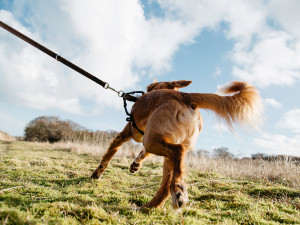Understanding Limber Tail Syndrome: Causes, Symptoms and Treatment
Seeing your pup’s normally perky tail go limp can be unnerving, but it’s really nothing to panic about
After a full day of activity, your normally rambunctious dog starts to act strange. They may sit down slowly like they’re an 80-year-old with arthritis rather than plopping down like usual. Or maybe their tail that’s usually whacking everything in sight suddenly stills and hangs limp. This flaccid tail creates some concern because it’s often the biggest indicator of your dog’s comfort and happiness level.
At this point, you worry that the tail is broken or severely injured. You try to think back and remember if your pup did anything unusual during the day but can’t think of anything – not even a yip of pain while they were playing. Now your dog won’t even let you look back there. What could be causing your dog’s tail to be limp and painful?
What is limber tail syndrome?
Limber tail is a condition in which dogs develop a flaccid or floppy tail, often despite having a stiff tail base. This problem usually resolves on its own relatively quickly but is painful. The scientific name for this syndrome is acute caudal myopathy, which is just a fancy way of saying that there’s a sudden onset of problems with the muscles of the tail.
This syndrome has had many other names over the years, including ‘cold tail’, ‘limp tail’, ‘frozen tail’, ‘swimmer’s tail’, ‘dead tail’, ‘rudder tail’ and (adorably) ‘broken wag’. It’s usually a safe bet to say that there’s some mystery around a medical condition when it has half a dozen names. Limber tail definitely fits this truism. Happily, whatever you decide to call it, this painful problem tends to resolve on its own pretty quickly.
What causes limber tail syndrome?
An important note: while this condition has the nickname ‘swimmer’s tail’, not all the affected dogs in the study that introduced this name had been swimming prior to the onset of symptoms. Researchers classified swimming as a potential risk factor. Interestingly, researchers also found that Labradors who suffered limber tail were more likely to be related to each other than unaffected dogs, which may indicate an underlying genetic risk factor.
This was the first large-scale study of limber tail syndrome. Researchers hope that further studies will identify genes associated with the condition, which could help breeders identify animals that are likely to be affected. Over time, this could help reduce the disease prevalence.
Officially referred to as acute caudal myopathy, limber tail syndrome is a condition in dogs that causes the dog��’s tail to become flaccid, usually after spending too much time playing in the water or overusing their tail while playing. The root cause for limber tail is not definitively known. The common factor seems to be a sudden uptick in tail activity, but not every dog who wags excessively develops this condition. Some causesopens in new tab of limp tail in dogs include:
Prolonged cage transport: dogs who are transported while in a crate may injure their tail as they try to use it to maintain balance in a restricted area.
Under-conditioning and overexertion: these injuries often follow a day of heavy activity after a longer period of minimal activity.
Climate, especially cold, wet weather: the condition seems to occur more frequently in colder climates, though it is still seen regularly in warm weather.
Swimming: there is an increased risk of occurrence after swimming or water activity.
It is also possible that there is a genetic factor involved in this condition. One studyopens in new tab found that Labrador Retrievers suffering from limber tail were more likely to be related to each other than unaffected dogs. It’s unclear if it was because these related dogs were more likely to have similar lifestyles or if there is a gene that is causing susceptibility to this syndrome.
Not every droopy tail is because of limber tail. Dogs who have suffered direct trauma to their tails will have similar symptoms. Anal gland issues can also cause dogs to clamp their tail down to guard the area. Getting a painful bum evaluated by a veterinarian can help make sure there’s nothing more serious going on back there.
What dog breeds are more likely to develop limber tail?
In 2016, a team at the University of Edinburgh wanted to study cases of the limber tailopens in new tab in order to understand the habits and lifestyles that might explain why some dogs are affected and others are not. The researchers confirmed that limber tail syndrome is more likely to show up in athletic, working breed dogs.
Researchers also found that dogs with limber tails were more likely to live in northern areas, lending some support to anecdotal reports that the condition is associated with exposure to the cold. But don’t take this as a hard-and-fast rule: many dogs have experienced this issue in warm weather, especially while swimming.
These limber tail dog breeds include:
Labrador Retrievers
English Pointers
English Setters
Flat-Coated Retrievers
Beagles
Foxhounds
Dalmatians
Coonhounds
Doberman Pinschers (with undocked tails, naturally)
How is limber tail syndrome diagnosed?
Thankfully, limber tail isn’t a life-threatening condition, but this often causes it to be overlooked and underestimated. Limber tail is not often reported to vets because symptoms usually resolve on their own within a few days or weeks.
The best treatment for limber tail is rest, so encourage your dog to take it easy for a few days. However, limber tail is thought to be very painful and distressing for affected dogs, so if the condition doesn’t resolve or show signs of improvement, contact your vet who may prescribe pain relief and anti-inflammatory medication to ease the discomfort for your dog. After a little rest and relaxation, your pup and their tail will be wagging again in no time.
Seeing your veterinarian is the best way to diagnose limber tail and rule out other issues that can look similar to it. Diagnosis is made after your vet collects a thorough history and performs an examination. Some common symptomsopens in new tab of limber tail in dogs include:
stiff tail base
limp tail end
pain when the tail is touched, often 5–10cm from the base
erect hair at tail base
pain when sitting
holding tail off to one side
decreased temperatureopens in new tab around the base of the tail
Researchers have developed some very fancy waysopens in new tab to look for changes that indicate limber tail. These can include MRIs, muscle biopsies, measurement of muscle proteins, nerve stimulation testing and even thermal imaging. That’s a big array of tests for any dog, especially one that was very likely feeling fine earlier in the day.
Fortunately, most cases are diagnosed based on history and physical examination alone. If there is any concern about trauma to the tail, radiographs of the area may be recommended to make sure there are no broken bones. This is much less invasive than a battery of tests and can be accomplished in most vet clinics.
How is limber tail syndrome treated?
Treatment for limber tail is usually very basic. Most dogs with this condition recover on their own over a period of about three to 14 daysopens in new tab, but it is worth seeing your vet for treatment because it is so painful. No dog wants to spend a week or two being uncomfortable every time they sit down or try to poo. Common therapies for limber tail include:
non-steroidal anti-inflammatory drugs (NSAIDs)
supplementary pain medications like gabapentin
warm compresses to the base of the tail
activity restriction
Most dogs treated with NSAIDs feel significantly better within 24 hours, but their activity should still be restricted for five to seven days to help prevent re-injury. That’s always easier for your vet to say than it is for you to do once your dog is back to feeling great.
Is there home treatment for limber tail syndrome?
Home treatment for limber tail syndrome includes rest and warm compresses to the tail. Compresses can be great to help with pain and healing, but don’t force the issue if your dog is still tender back there. The goal is to make them feel better, not torture them.
Most cases will resolve on their own within days to weeks, but seeing your vet for care can speed recovery and increase your dog’s comfort level. Do not use any over-the-counter pain medications for this condition because they can cause more harm than good.
When should I consult a veterinarian?
Consult your vet early on to confirm that your dog has limber tail and not another problem that is causing similar symptoms. Your vet can give you assurance that this is a simple problem that will resolve with conservative care. They can also prescribe safe, effective pain medication for your dog.
Can limber tail syndrome recur?
Limber tail syndrome can recur. A little over 40 percent of dogs will have a recurrence, with some dogs having multiple recurrences throughout their life. Because most dogs recover quickly, these events usually aren’t a big hit to their quality of life. Despite this, some lifestyle changes may be needed if your dog is having ongoing problems with this condition.
Can limber tail syndrome be prevented?
Limber tail syndrome is unpredictable, but there are some things you can do to help limit your dog’s risk. If you’re taking a long trip with your dog in a crate or kennel, stop every two to four hours to get them out and give them a break. Gradually ramp up activity, especially water activities. Don’t let your dog go from lazing around all winter to having a full day at the beach as soon as the weather is nice.
Although it can be very scary when your dog’s tail suddenly stops wagging, there’s no reason for serious concern if it’s due to limber tail syndrome. This condition is pretty painful, so some vet care and basic at-home support will keep your dog as comfortable as possible. Fortunately, most dogs recover well and get back to trying to whip your knees with their tail within a few days.
Frequently asked questions
What are the symptoms of limber tail syndrome?
Symptoms of limber tail syndrome include a stiff tail base, limp tail, pain, erect hair at the base of the tail and holding the tail off to one side.
What causes limber tail syndrome?
The cause of limber tail syndrome is unknown but seems to be related to increased tail activity. Some risk factors are recent swimming and transport in a crate.
How is limber tail syndrome diagnosed?
Limber tail syndrome is often diagnosed by a vet based on history and physical examination alone. X-rays may help rule out other causes for tail pain.
How is limber tail syndrome treated?
Limber tail syndrome is usually treated with pain medication and activity restriction. Most dogs recover within a couple of days to a couple of weeks.
Can limber tail syndrome be prevented?
There’s no sure way to prevent limber tail syndrome, but breaking up time being transported in a crate and avoiding a sudden increase in water activity may help.
When should I consult a veterinarian?
Consult a veterinarian if you feel your dog is in pain or acts uncomfortable around their tail.
Can limber tail syndrome recur?
Limber tail syndrome will recur in a little less than half of dogs that develop it. Some dogs may have a genetic predisposition to the condition.
Is there home treatment for limber tail syndrome?
After you see your vet for diagnosis, home treatment usually consists of medication, activity restriction and warm compresses of the tail to help speed healing.















